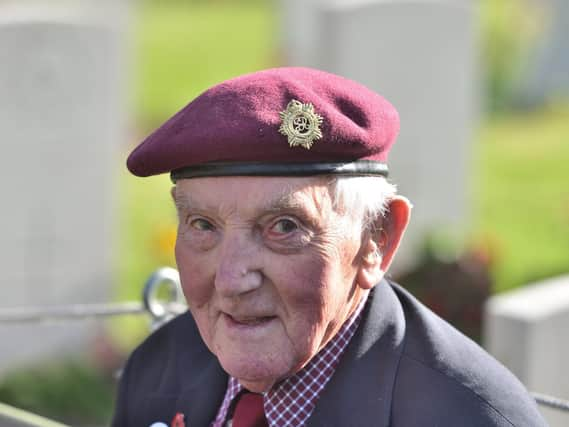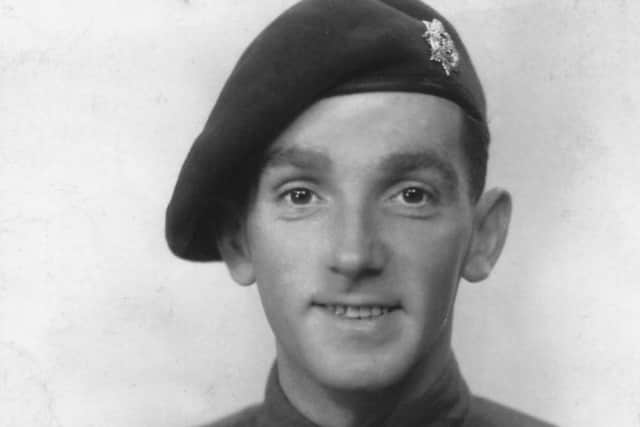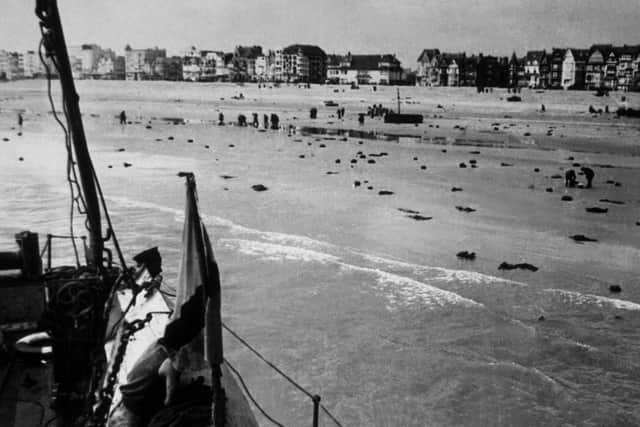Meet the 101-year-old Yorkshireman who escaped from Dunkirk and fought at Arnhem


Just six years later he found himself in an altogether different world – driving a truck with the British Army and fighting the Germans in Belgium and France.
Raymond was called up to the Royal Army Service Corps in September 1939. He was sent to Margate for basic training and was part of the British Expeditionary Force (BEF) that sailed to France.
Advertisement
Hide AdAdvertisement
Hide AdWhen the Germans invaded Belgium in May 1940, Raymond was among those sent to fight them. “It was my job to deliver petrol when and where it was needed,” says Raymond, now aged 101.


As the Germans pushed the British and French soldiers back towards the Channel he was among those holding them off as part of a rearguard action. “I was with the infantry and we were told to take up positions and defend a crossroads to allow people to get to Dunkirk.
“Then we were told it was every man for himself and I set off for Dunkirk which was a few miles away so I drove as I still had a vehicle.”
He vividly remembers the scene that greeted him. “When I got to Dunkirk the beach was a mass of British soldiers. There was the odd attack from bombers that came over. I was scared and so was everybody else because we didn’t really know what was happening.”


Advertisement
Hide AdAdvertisement
Hide Ad“I looked around and I couldn’t see any ships nearby, there were some out to sea but they hadn’t come in and I thought ‘this is no place for me.’”
Rather than sit tight and wait, Raymond made a bold move for survival and drove south to Lille. Here he met another British officer and
then a group of English nurses who were also desperately trying to get home.
Together they made a beeline for the railway station. “We all went to the station master and he was horrified to see these girls. Thankfully one of them could speak French which was a big help and in the end he allowed us to get in the last carriage of a train that was going to Cherbourg.”
Advertisement
Hide AdAdvertisement
Hide AdThey made a “long and slow” train journey westwards and arrived at the French port, which had not yet been taken by the Germans, and began looking for ways to get back to England.
“I walked down to the harbour with these 18 girls and we came across a Dutch fishing boat. The captain said he was waiting for the tide and was then going to sail to Southampton. He said, ‘if you want to come with me, you can.’ So we were delighted.
“This was at about seven o’clock at night. We had to wait until early next morning and climbed on board and then we set off and got back safely to England.”
What Raymond didn’t know at the time was that Dunkirk had been the scene of a dramatic and fraught 10-day evacuation.
Advertisement
Hide AdAdvertisement
Hide AdOn June 4, as the last of the exhausted soldiers arrived back in England, Winston Churchill, who had been Prime Minister for less than a month, stood up in the House of Commons and gave a moving speech in which he gave thanks for what he described as the “miracle of deliverance” from Dunkirk.
It had indeed been miraculous. The evacuation, codenamed Operation Dynamo, involved a hastily assembled flotilla of 900 naval and civilian craft that travelled back and forth across the Channel to rescue allied soldiers, mostly British and French, who were stranded on the beaches outside the town on the northern French coast.
Many of these were privately owned boats, including tugs, pleasure cruisers and a 15ft fishing dinghy – the smallest vessel in the flotilla. Despite the risk to themselves and coming under near constant attack by the Luftwaffe, they ploughed on and by the time the last man was pulled up from the surf some 338,226 troops had been saved to fight another day.
The rescue mission came at a high price with 5,000 soldiers killed and 235 vessels destroyed. Despite such heavy casualties it could have been far worse and the soldiers who made it back to England were treated like returning heroes. Their bravery and that of the redoubtable crews of the famous ‘little ships of Dunkirk’, as they became known, has since gone down in folklore.
Advertisement
Hide AdAdvertisement
Hide AdFor Raymond, there was little respite and he soon joined the 1st Airborne Division and underwent parachute training. He subsequently saw action in North Africa, Sicily and Italy before returning to England in 1944 to take part in Operation Market Garden – the operation saw around 35,000 allied soldiers land by parachute and gliders behind enemy lines in an ambitious, but failed, bid to secure bridges to open up a route into Germany.
Raymond was among those who saw action at Arnhem. “We landed about eight miles from Arnhem and I was posted on the perimeter with five other chaps and we dug in and guarded that area.”
He was there for nine days. “An officer came round at the end and said we were pulling out that night. We were told to go down to the river and when it got dark we pulled out. But then we ran into a German patrol, shots were fired and grenades were thrown and everybody scattered.”
He found himself under a bridge and made his way along the Rhine. “After about a mile-and-a-half I came to a group of English soldiers waiting for the Canadians who had rowing boats on the other bank. They came across and took five men each time and I waited my turn and eventually I got away.”
Advertisement
Hide AdAdvertisement
Hide AdRaymond was in Norway when the war finally ended. In the spring of 1945 the 1st Airborne Division was sent to an airstrip near Oslo where a group of German generals surrendered.
He returned to England in June and stayed in the army before being demobbed in 1946 at which point he went back home to Yorkshire.
Raymond’s father had been head gardener at nearby Scampston Hall, and he himself was a seeds expert and after working briefly in Leeds returned to Malton to run his own seed shop which grew into a greengrocers where he worked for many years.
However, he never forgot his wartime experiences and has returned to Dunkirk numerous times over the intervening years. “I would stroll around the town, it’s an amazing feeling. A feeling of relief that I got away,” he says.
Advertisement
Hide AdAdvertisement
Hide Ad“What we saw was so vivid in those days that you don’t forget. We were totally in the dark and we didn’t know what was happening, but I knew I was always going to survive, I had that in mind.”
The men that were left behind
In the weeks immediately following the rescue mission at Dunkirk, the evacuation continued with 160,000 Allied soldiers – including British, French, Belgians, Czechs and Canadians – escaping via ports stretching from Normandy all the way down to the Bay of Biscay.
For all the relief at the number of men who were brought back, the British Army had still suffered a humiliating defeat.
The BEF abandoned 2,472 guns, nearly 65,000 vehicles and more than 75,000 tons of much-needed ammunition in northern France.
Advertisement
Hide AdAdvertisement
Hide AdThis is rarely mentioned in the retelling of what happened at Dunkirk. Neither is the fact that more than 40,000 British soldiers who didn’t escape were marched off into captivity.
Editor’s note: first and foremost - and rarely have I written down these words with more sincerity - I hope this finds you well.
Almost certainly you are here because you value the quality and the integrity of the journalism produced by The Yorkshire Post’s journalists - almost all of which live alongside you in Yorkshire, spending the wages they earn with Yorkshire businesses - who last year took this title to the industry watchdog’s Most Trusted Newspaper in Britain accolade.
And that is why I must make an urgent request of you: as advertising revenue declines, your support becomes evermore crucial to the maintenance of the journalistic standards expected of The Yorkshire Post. If you can, safely, please buy a paper or take up a subscription. We want to continue to make you proud of Yorkshire’s National Newspaper but we are going to need your help.
Advertisement
Hide AdAdvertisement
Hide AdPostal subscription copies can be ordered by calling 0330 4030066 or by emailing [email protected]. Vouchers, to be exchanged at retail sales outlets - our newsagents need you, too - can be subscribed to by contacting subscriptions on 0330 1235950 or by visiting www.localsubsplus.co.uk where you should select The Yorkshire Post from the list of titles available.
If you want to help right now, download our tablet app from the App / Play Stores. Every contribution you make helps to provide this county with the best regional journalism in the country.
Sincerely. Thank you.
James Mitchinson
Editor